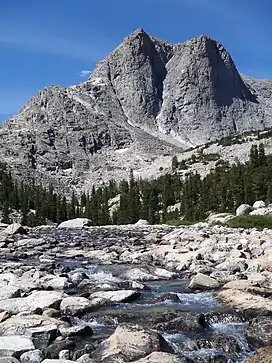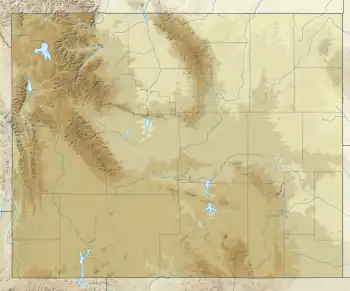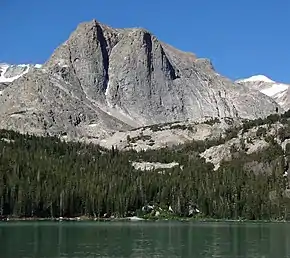| Spider Peak | |
|---|---|
 Northeast aspect | |
| Highest point | |
| Elevation | 12,234 ft (3,729 m)[1][2] |
| Prominence | 834 ft (254 m)[1] |
| Parent peak | Downs Mountain (13,355 ft)[3] |
| Isolation | 0.86 mi (1.38 km)[3] |
| Coordinates | 43°19′27″N 109°39′10″W / 43.32417°N 109.65278°W[4] |
| Geography | |
 Spider Peak Location in Wyoming  Spider Peak Spider Peak (the United States) | |
| Location | Fremont County, Wyoming, U.S. |
| Parent range | Wind River Range |
| Topo map | USGS Temple Peak |
| Geology | |
| Type of rock | granitic |
| Climbing | |
| First ascent | July 18, 1960 |
| Easiest route | class 3[3] North ridge |
Spider Peak is a 12,234-foot-elevation (3,729-meter) mountain summit located in Fremont County of Wyoming, United States.[4]
Geography
The peak is situated 1.5 mile east of the Continental Divide in the northern portion of the remote Wind River Range. It is set in the Fitzpatrick Wilderness, on land managed by Shoshone National Forest. Neighbors include Downs Mountain, 1.4 mile to the southwest, and Torrey Peak 2.4 miles to the northeast. Topographic relief is significant as the east aspect rises 1,700 feet (520 meters) above Turquoise Lake in one-half mile. Precipitation runoff from the mountain drains into Torrey Creek, which is a tributary of the Wind River.
Climate
According to the Köppen climate classification system, Spider Peak is located in an alpine subarctic climate zone with long, cold, snowy winters, and cool to warm summers.[5] Due to its altitude, it receives precipitation all year, as snow in winter, and as thunderstorms in summer. This climate supports the nearby Continental Glacier and East Torrey Glacier.
Climbing
Established climbing routes:[6]
- North Ridge – first ascent 1960 – Dave Dornan, Maurice Horn
- East Buttress – (II 5.7) – 1964 – Fred Beckey, Jerry Fuller, Alex Bertulis
- Southwest Ridge – class 5.5 – 1972 – Vince Lee, Dennis Pierce, Terry Sawyer, Tom Wolff
- Southeast Face – (II 5.6) – 1975 – Tom Warren and party
- Northeast Buttress – (III 5.8) – 1975 – Fred Beckey, Steve Jackson, Brian Leo
- Northeast Face – (IV 5.9) – 1978 – Randy Cerf, Herbie Ogden, George Schunk
The 1960 first ascent party named the peak based on the numerous hairy, dark-brown spiders they encountered here.[7]
Hazards

Encountering bears is a concern in the Wind River Range.[8] There are other concerns as well, including bugs, wildfires, adverse snow conditions and nighttime cold temperatures.[9]
Importantly, there have been notable incidents, including accidental deaths, due to falls from steep cliffs (a misstep could be fatal in this class 4/5 terrain) and due to falling rocks, over the years, including 1993,[10] 2007 (involving an experienced NOLS leader),[11] 2015[12] and 2018.[13] A 54-year-old climber from Durango fell 400–800 feet to his death from Steeple Peak in 2017.[14] Other incidents include a seriously injured backpacker being airlifted near Squaretop Mountain[15] in 2005,[16] and a fatal hiker incident (from an apparent accidental fall) in 2006 that involved state search and rescue.[17] The U.S. Forest Service does not offer updated aggregated records on the official number of fatalities in the Wind River Range.
See also
References
- 1 2 "Spider Peak, Wyoming". Peakbagger.com. Retrieved 2021-07-30.
- ↑ Joe Kelsey, 2013, Climbing and Hiking in the Wind River Mountains, Falcon Guides, ISBN 9781493001354, page 81.
- 1 2 3 "Spider Peak - 12,234' WY". listsofjohn.com. Retrieved 2021-07-29.
- 1 2 "Spider Peak". Geographic Names Information System. United States Geological Survey, United States Department of the Interior. Retrieved 2021-07-30.
- ↑ Peel, M. C.; Finlayson, B. L.; McMahon, T. A. (2007). "Updated world map of the Köppen−Geiger climate classification". Hydrol. Earth Syst. Sci. 11. ISSN 1027-5606.
- ↑ Joe Kelsey, 2013, Climbing and Hiking in the Wind River Mountains, Falcon Guides, ISBN 9781493001354, page 418.
- ↑ Orrin H. Bonney, Lorraine G. Bonney, 1965, Guide to the Wyoming Mountains and Wilderness Areas, Sage Books, page 83.
- ↑ Staff (April 24, 2017). "Bear Safety in Wyoming's Wind River Country". WindRiver.org. Retrieved February 17, 2019.
- ↑ Ballou, Dawn (July 27, 2005). "Wind River Range condition update - Fires, trails, bears, Continental Divide". PineDaleOnline News. Retrieved February 17, 2019.
- ↑ Staff (1993). "Falling Rock, Loose Rock, Failure to Test Holds, Wyoming, Wind River Range, Seneca Lake". American Alpine Club. Retrieved February 15, 2019.
- ↑ MacDonald, Dougald (August 14, 2007). "Trundled Rock Kills NOLS Leader". Climbing. Retrieved February 15, 2019.
- ↑ Staff (December 9, 2015). "Officials rule Wind River Range climbing deaths accidental". Casper Star-Tribune. Retrieved February 15, 2019.
- ↑ Dayton, Kelsey (August 24, 2018). "Deadly underestimation". WyoFile News. Retrieved February 15, 2019.
- ↑ Nick Learned, Climber Falls to His Death in Wyoming’s Wind River Range, August 31, 2017, k2radio.com
- ↑ Funk, Jason (2009). "Squaretop Mountain Rock Climbing". Mountain Project. Retrieved March 29, 2019.
- ↑ Staff (July 22, 2005). "Injured man rescued from Square Top Mtn - Tip-Top Search & Rescue helps 2 injured on the mountain". PineDaleOnline News. Retrieved February 17, 2019.
- ↑ Staff (September 1, 2006). "Incident Reports - September, 2006 - Wind River Search". WildernessDoc.com. Retrieved February 17, 2019.
External links
- Spider Peak rock climbing: Mountainproject.com
- Weather forecast: Spider Peak